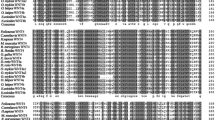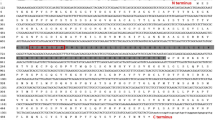Abstract
Dynein axonemal light intermediate chain 1 (dnali1) is an important part of axonemal dyneins and plays an important role in the growth and development of animals. However, there is little information about dnali1 in fish. Herein, we cloned dnali1 gene from the genome of olive flounder (Paralichthys olivaceus), a commercially important maricultured fish in China, Japan, and Korea, and analyzed its expression patterns in different gender fish. The flounder dnali1 DNA sequence contained a 771 bp open reading frame (ORF), two different sizes of 5′ untranslated region (5′UTR), and a 1499 bp 3′ untranslated region (3′UTR). Two duplicated 922 nt fragments were found in dnali1 mRNA. The first fragment contained the downstream coding region and the front portion of 3′UTR, and the second fragment was entirely located in 3′UTR. Multiple alignments indicated that the flounder Dnali1 protein contained the putative conserved coiled-coil domain. Its expression showed sexually dimorphic with predominant expression in the flounder testis, and lower expression in other tissues. The gene with the longer 5′UTR was specifically expressed in the testis. The highest expression level in the testis was detected at stages IV and V. Transient expression analysis showed that the 922 bp repeated sequence 3′UTR of dnali1 down-regulated the expression of GFP at the early stage in zebrafish. The flounder dnali1 might play an important role in the testis, especially in the period of spermatogenesis, and the 5′UTR and the repetitive sequences in 3′UTR might contain some regulatory elements for the cilia.





Similar content being viewed by others
Abbreviations
- dnali1 :
-
Dynein axonemal light intermediate chain 1
- ORF:
-
Open reading frame
- 5′UTR:
-
5′ Untranslated region
- 3′UTR:
-
3′ Untranslated region
- TL:
-
Total length; MS222, tricaine methane sulfonate
- HE:
-
Hematoxylin/eosin
- RT-PCR:
-
Reverse transcription polymerase chain reaction
- RACE:
-
Rapid amplification of cDNA ends
- qPCR:
-
Real-time quantitative polymerase chain reaction
- IDA:
-
Inner dynein arms
- ODA:
-
Outer dynein arms
References
Paschal BM, Vallee RB (1987) Retrograde transport by the microtubule-associated protein MAP 1C. Nature 330:181–183. https://doi.org/10.1038/330181a0
Holzbaur ELF, Vallee RB (1994) Dyneins: molecular structure and cellular fnction. Genet Mol Res 10:339–372. https://doi.org/10.1146/annurev.cb.10.110194.002011
Cypranowska C, Yildiz A, Ishikawa T (2016) Dyneins. In: Cypranowska CA, Yildiz A, Ishikawa T (eds) Encyclopedia of Cell Biology. Elsevier, Amsterdam, pp 620–636
King SM (2000) AAA domains and organization of the dynein motor unit. J Cell Sci 113(Pt 14):2521–2526. https://doi.org/10.2307/3583618
Yamaguchi H, Oda T, Kikkawa M, Takeda H (2018) Systematic studies of all PIH proteins in zebrafish reveal their distinct roles in axonemal dynein assembly. Elife. https://doi.org/10.7554/eLife.36979
Leventea E, Hazime K, Zhao C, Malicki J (2016) Chapter 9 - Analysis of cilia structure and function in zebrafish. In: Detrich HW, Westerfield M, Zon LI (eds) Methods in Cell Biology. Academic Press, Cambridge, pp 179–227
Subramanian A, Kabi A, Gray SF, Pennock D (2016) p28 dynein light chains and ciliary motility in Tetrahymena thermophila. Cytoskeleton 73:197–208. https://doi.org/10.1002/cm.21295
LeDizet M, Piperno G (1995) The light chain p28 associates with a subset of inner dynein arm heavy chains in Chlamydomonas axonemes. Mol Biol Cell 6:697–711. https://doi.org/10.1091/mbc.6.6.697
Kumar S, Stecher G, Tamura K (2016) MEGA7: molecular evolutionary genetics analysis version 7.0 for bigger datasets. Mol Biol Evol 33:1870–1874. https://doi.org/10.1093/molbev/msw054
Zariwala MA, Gee HY, Kurkowiak M, Al-Mutairi DA, Leigh MW, Hurd TW, Hjeij R, Dell SD, Chaki M, Dougherty GW et al (2013) ZMYND10 is mutated in primary ciliary dyskinesia and interacts with LRRC6. Am J Hum Genet 93:336–345. https://doi.org/10.1016/j.ajhg.2013.06.007
Babushok DV, Ostertag EM, Kazazian HH (2007) Current topics in genome evolution: molecular mechanisms of new gene formation. Cell Mol Life Sci 64:542–554. https://doi.org/10.1007/s00018-006-6453-4
Letunic I, Copley RR, Bork P (2002) Common exon duplication in animals and its role in alternative splicing. Hum Mol Genet 11:1561–1567. https://doi.org/10.1093/hmg/11.13.1561
Arefeen A, Liu J, Xiao X, Jiang T, Berger B (2018) TAPAS: tool for alternative polyadenylation site analysis. Bioinformatics 34:2521–2529. https://doi.org/10.1093/bioinformatics/bty110
Zhong J, Peters AHFM, Kafer K, Braun RE (2001) A highly conserved sequence essential for translational repression of the protamine 1 messenger RNA in murine spermatids1. Biol Reprod 64:1784–1789. https://doi.org/10.1095/biolreprod64.6.1784
Zhong J, Peters AHFM, Lee K, Braun RE (1999) A double-stranded RNA binding protein required for activation of repressed messages in mammalian germ cells. Nat Genet 22:171–174. https://doi.org/10.1038/9684
Giraldez AJ, Mishima Y, Rihel J, Grocock RJ, Van DS, Inoue K, Enright AJ, Schier AF (2006) Zebrafish MiR-430 promotes deadenylation and clearance of maternal mRNAs. Science 312:75–79. https://doi.org/10.1126/science.1122689
Sandler H, Stoecklin G (2008) Control mRNA decay by phosphorylation of tristetraprolin. Biochem Soc T 36:491–496. https://doi.org/10.1042/BST0360491
Mishima Y, Tomari Y (2016) Codon usage and 3’ UTR length determine maternal mRNA stability in zebrafish. Mol Cell 61:874–885. https://doi.org/10.1016/j.molcel.2016.02.027
Fujiwara A, Fujiwara M, Nishida-Umehara C, Masaoka AS, T, (2007) Characterization of Japanese flounder karyotype by chromosome bandings and fluorescence in situ hybridization with DNA markers. Genetica 131:267–274. https://doi.org/10.1007/s10709-006-9136-z
Fan ZF, You F, Wang LJ, Weng SD, Wu ZH, Hu JW, Zou YX, Tan XG, Zhang PJ (2014) Gonadal transcriptome analysis of male and female olive flounder (Paralichthys olivaceus). Biomed Res Int 2014:291067. https://doi.org/10.1155/2014/291067
Sun P, You F, Zhang LJ, Wen AY, Wu ZH, Xu DD, Zhang PJ (2009) Histological evaluation of gonadal differentiation in olive flounder (Paralichthys olivaceus). Mar Sci 33:53–58. https://doi.org/10.1007/978-1-4020-9623-5_5
Fornes O, Castro-Mondragon JA, Khan A, Lee RVD (2020) Mathelier A (2020) JASPAR 2020: update of the open-access database of transcription factor binding profiles. Nucleic Acids Res 48(D1):D87–D92. https://doi.org/10.1093/nar/gkz1001
Zheng WJ, Sun L (2011) Evaluation of housekeeping genes as references for quantitative real time RT-PCR analysis of gene expression in Japanese flounder (Paralichthys olivaceus). Fish Shellfish Immun 30:638–645. https://doi.org/10.1016/j.fsi.2010.12.014
Livak KJ, Schmittgen TD (2001) Analysis of relative gene expression data using real-time quantitative PCR and the 2 (-Delta Delta C(T)) Method. Methods 25:402–408. https://doi.org/10.1006/meth.2001.1262
Li MJ, Tan XG, Jiao S, Wang Q, Wu ZH, You F, Zou YX (2015) A new pattern of primordial germ cell migration in olive flounder (Paralichthys olivaceus) identified using nanos3. Dev Genes Evol 225:195–206. https://doi.org/10.1007/s00427-015-0503-6
Nagasaki H, Arita M, Nishizawa T, Suwa M, Gotoh O (2005) Species-specific variation of alternative splicing and transcriptional initation in six eukaryotes. Gene 364:53–62. https://doi.org/10.1016/j.gene.2005.07.027
Barrett LW, Fletcher S, Wilton SD (2012) Regulation of eukaryotic gene expression by the untranslated gene regions and other non-coding elements. Cell Mol Life Sci 69:3613–3634. https://doi.org/10.1007/s00018-012-0990-9
Hughes TA (2006) Regulation of gene expression by alternative untranslated regions. Trends Genet 22:119–122. https://doi.org/10.1016/j.tig.2006.01.001
Kiselak EA, Shen X, Song J, Gude DR, Wang J, Brody SL, Strauss JF, Zhang Z (2010) Transcriptional regulation of an axonemal central apparatus gene, sperm-associated antigen 6, by a SRY-related high mobility group transcription factor, S-SOX5. J Biol Chem 285:30496–30505. https://doi.org/10.1074/jbc.M110.121590
She ZY, Yang WX (2017) Nucleocytoplasmic shuttling of SOX14A and SOX14B transcription factors. Oncotarget 8(29):46955–46968
Gritsun TS, Gould EA (2006) The 3’ untranslated region of tick-borne flaviviruses originated by the duplication of long repeat sequences within the open reading frame. Virology 354:217–223. https://doi.org/10.1016/j.virol.2006.03.052
Vallente R, Eichler E (2002) OPINION Segmental duplications and the evolution of the primate genome. Nat Rev Genet 3:65–72. https://doi.org/10.1038/nrg705
Peng T, Li Y (2009) Tandem exon duplication tends to propagate rather than to create de novo alternative splicing. Biochem Biophys Res Commun 383:163–166. https://doi.org/10.1016/j.bbrc.2009.03.162
Moore AD, Bjorklund AK, Ekman D, Bornberg-Bauer E, Elofsson A (2008) Arrangements in the modular evolution of proteins. Trends Biochem Sci 33:444–451. https://doi.org/10.1016/j.tibs.2008.05.008
Trump N, Cullup T, Verheij JB, Manzur A, Muntoni F, Abbs S, Jungbluth H (2012) X-linked myotubular myopathy due to a complex rearrangement involving a duplication of MTM1 exon 10. Neuromuscul Disord 22:384–388. https://doi.org/10.1016/j.nmd.2011.11.004
Rashid S, Breckle R, Hupe M, Geisler S, Doerwald N, Neesen J (2006) The murine Dnali1 gene encodes a flagellar protein that interacts with the cytoplasmic dynein heavy chain 1. Mol Reprod Dev 73:784–794. https://doi.org/10.1002/mrd.20475
Inaba A, Furuhata M, Morimoto K, Rahman M, Takahashi O, Hijikata M, Knowles MR, Keicho N (2019) Primary ciliary dyskinesia in Japan: systematic review and meta-analysis. BMC Pulm Med 19:135. https://doi.org/10.1186/s12890-019-0897-4
Kumar K, Taylor WE, Shen R, Stefan A, Matthew G, Fisher CE, Coucke PJ, Peter VH, Guy VC, Shalender B (1997) Complementary deoxyribonucleic acid cloning and characterization of a putative human axonemal dynein light chain gene 1. J Clin Endocr Metab 82:3047–3053. https://doi.org/10.1210/jcem.82.9.4242
Liu ZB, Tu HQ, Kang YS, Xue YY, Ma DY, Zhao CT, Li HY, Wang L, Liu F (2019) Primary cilia regulate hematopoietic stem and progenitor cell specification through Notch signaling in zebrafish. Nat Commun 10:1839. https://doi.org/10.1038/s41467-019-09403-7
Kobayashi D, Asano-Hoshino A, Nakakura T, Nishimaki T, Ansai S, Kinoshita M, Ogawa M, Hagiwara H, Yokoyama T (2017) Loss of zinc finger MYND-type containing 10 (zmynd10) affects cilia integrity and axonemal localization of dynein arms, resulting in ciliary dysmotility, polycystic kidney and scoliosis in medaka (Oryzias latipes). Dev Biol 430:69–79. https://doi.org/10.1016/j.ydbio.2017.08.016
Kamiya R, Kurimoto E, Muto E (1991) Two types of Chlamydomonas flagellar mutants missing different components of inner-arm dynein. J Cell Biol 112:441–447. https://doi.org/10.1083/jcb.112.3.441
Sun JJ, Wu ZH, Zhong T (2016) Cilia function in cell signaling and organ development. Sci Sin Vitae 46:354–362. https://doi.org/10.1360/N052016-00134
Samsa LA, Givens C, Tzima E, Stainier DY, Qian L, Liu J (2015) Cardiac contraction activates endocardial Notch signaling to modulate chamber maturation in zebrafish. Development 142:4080–4091. https://doi.org/10.1242/dev.125724
Mayr C (2019) What are 3’ UTRs doing? Cold spring harb perspect Biol. https://doi.org/10.1101/cshperspect.a034728
Yazawa R, Hirono I, Aoki T (2005) Characterization of promoter activities of four different Japanese flounder promoters in transgenic zebrafish. Mar Biotechnol (NY) 7:625–633. https://doi.org/10.1007/s10126-005-0011-1
Yazawa R, Hirono I, Aoki T (2006) Transgenic zebrafish expressing chicken lysozyme show resistance against Bacterial Diseases. Transgenic Res 15:385–391. https://doi.org/10.1007/s11248-006-0009-0
Kim B, Kim HM, Kang MK, Sohn DH, Han SJ (2020) 5’-UTR and ORF elements, as well as the 3’-UTR regulate the translation of Cyclin. Biochem Biophys Res Commun 527:968–973. https://doi.org/10.1016/j.bbrc.2020.04.151
Acknowledgements
This work was supported by the projects from the National Sciences of Foundation of China (Nos. 31772834, 31672636, and 31702337), and the National Key R&D Program of China (No. 2018YFD0900202) and Key Technology Research and Development Program of Shandong (CN) (No. 2018YFD0901202).
Author information
Authors and Affiliations
Corresponding authors
Ethics declarations
Conflict of interest
Authors declare no conflict of interests.
Ethical approval
The studies were conducted in accordance with the Institutional Animal Care and Use Committee of the Institute of Oceanology, Chinese Academy of Sciences. All of applicable international, national, and institutional guidelines for the care and use of animals were followed by the authors.
Consent to participate
All the authors listed have approved the manuscript that is enclosed.
Consent for publication
The manuscript is approved by all authors for publication.
Additional information
Publisher's Note
Springer Nature remains neutral with regard to jurisdictional claims in published maps and institutional affiliations.
Supplementary Information
Below is the link to the electronic supplementary material.
11033_2021_6342_MOESM2_ESM.tif
Developmental stages of the flounder gonads. The stages were determined using histological section with HE staining (tif 21396 kb)
Rights and permissions
About this article
Cite this article
Wang, L., Tan, X., Zou, C. et al. Sexually dimorphic expression and regulatory sequence of dnali1 in the olive flounder Paralichthys olivaceus. Mol Biol Rep 48, 3529–3540 (2021). https://doi.org/10.1007/s11033-021-06342-9
Received:
Accepted:
Published:
Issue Date:
DOI: https://doi.org/10.1007/s11033-021-06342-9




